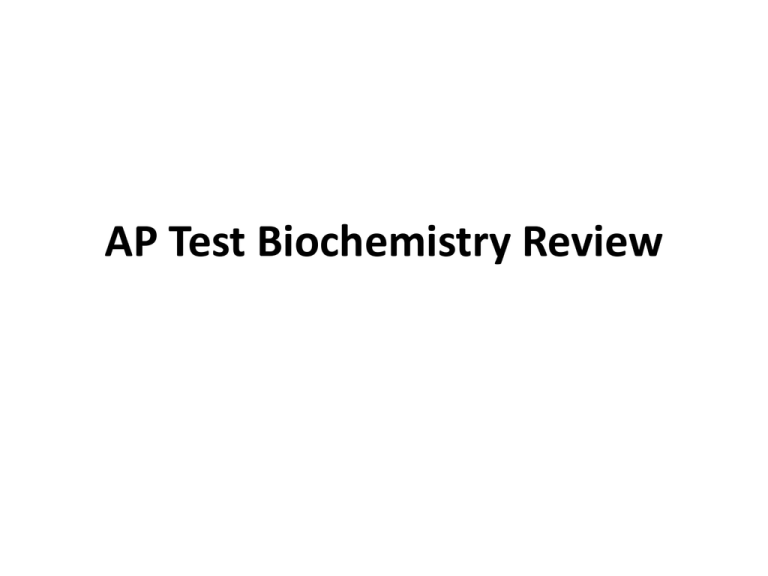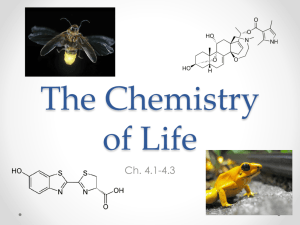AP Test Biochemistry Review
advertisement

AP Test Biochemistry Review Life requires ~25 chemical elements About 25 elements are essential for life Four elements make up 96% of living matter: • carbon (C) • oxygen (O) • hydrogen (H) • nitrogen (N) Four elements make up most of remaining 4%: • phosphorus (P) • calcium (Ca) • sulfur (S) • potassium (K) AP Biology 2005-2006 Ionic bonds Transfer of an electron Forms + & - ions + = cation – = anion Weak bond AP Biology example: salt = dissolves easily in water 2005-2006 Covalent bonds Two atoms need an electron Share a pair of electrons Strong bond both atoms holding onto the electrons Forms molecules example: AP Biology water = takes energy to separate 2005-2006 Polar covalent bonds Pair of electrons not shared equally by 2 atoms Water = O + H oxygen has stronger “attraction” for the shared electrons than hydrogen oxygen has higher electronegativity AP Biology 2005-2006 Polar covalent bonds 2 hydrogens in the water molecule form an angle Water molecule is polar oxygen end is – hydrogen end is + Leads to many interesting properties of water…. AP Biology 2005-2006 Hydrogen bonds Positive H atom in 1 water molecule is attracted to negative O in another Can occur wherever an -OH exists in a larger molecule Weak bonds AP Biology 2005-2006 Review Chapter 2 Matter is made of atoms Life requires ~25 chemical elements Atomic structure determines behavior of an element Atoms combine by chemical bonding to form molecules Weak chemical bonds play important roles in chemistry of life A molecule’s biological function is related to its shape Chemical reactions make & break chemical bonds AP Biology 2005-2006 Chemistry of water H2O molecules form H bonds with each other + attracted to – creates a sticky molecule AP Biology 2004-2005 Cohesion H bonding between H2O creates cohesion water is “sticky” surface tension drinking straw Water bugs Water moves up a tree AP Biology 2004-2005 Adhesion H2O molecules form H bonds with other substances meniscus water climbs up fiber ex. paper towel AP Biology 2004-2005 Water is the solvent of life H2O is a good solvent due to its polarity polar H2O molecules surround + & – ions solvents dissolve solutes creating aqueous solutions AP Biology 2004-2005 Hydrophilic Hydrophilic substances have affinity for H2O Polar: they have a charge AP Biology 2004-2005 Hydrophobic Hydrophobic substances do not have affinity for H2O Non-polar Oil, wax, fats AP Biology fat (triglycerol) 2004-2005 Ice is less dense then liquid water Ice floats! H bonds form a crystal with loose structure Molecules are further apart and less dense AP Biology 2004-2005 Specific heat H2O has high specific heat due to H bonding: it takes a lot of energy to change the temperature of water H2O resists changes in temperature takes a lot to heat it up takes a lot to cool it down H2O moderates temperatures on Earth AP Biology 2004-2005 Evaporative cooling Organisms rely on heat of vaporization (energy required to turn liquid to gas) to remove heat As bonds are broken, heat is released into the environment AP Biology 2004-2005 Water forms ions Hydrogen ion (H+) splits off from water to leave a hydroxide ion (-OH) H20 ----> H+ + -OH If concentration of 2 ions is equal, water is neutral If [H+] > [-OH], water is acidic If [-OH] > [H+], water is basic pH scale = how acidic or basic a solution is AP Biology 2004-2005 Chemistry of Life Organic chemistry is the study of carbon compounds C atoms are versatile building blocks 4 electrons in outer shell 4 stable covalent bonds AP Biology 2003-2004 Isomers Molecules with same molecular formula but different structures AP Biology different chemical properties 2003-2004 How to build a polymer Condensation reaction dehydration synthesis joins monomers by “taking” H2O out requires energy & enzymes AP Biology 2005-2006 How to break down a polymer Hydrolysis use H2O to break apart monomers reverse of condensation reaction H2O is split into H and OH AP Biology 2005-2006 Carbohydrates Lipids AP Biology Proteins Nucleic Acids 2005-2006 Metabolism Metabolism is the sum of all chemical reactions in your body. If a reactions breaks things down, it is catabolic If a reaction builds things up, it is anabolic AP Biology Energy is released or consumed In an exergonic reaction energy is released. When you break things down, you release energy All catabolic reactions are exergonic Cellular respiration is exergonic. These are spontaneous reactions Delta G (a measure of free energy) is negative AP Biology Energy is released or consumed In an endergonic reaction energy is absorbed. When you build things, you need energy All anabolic reactions are endergonic Photosynthesis is endergonic These are non-spontaneous reactions Delta G is positive AP Biology Enzymes! Enzymes are proteins. They are catalysts that speed up chemical reactions by lowering the amount of energy needed for those reactions to start (activation energy) AP Biology




